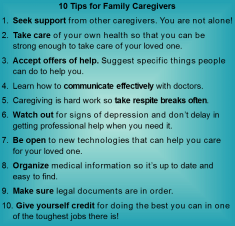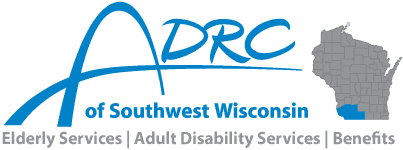Caregiver Corner
Are you an Informal Caregiver?
About 44 million Americans provide 37 billion hours of unpaid, “informal” care each year for adult family members and friends with chronic illnesses or conditions that prevent them from handling daily activities such as bathing, managing medications, or preparing meals on their own. Family caregivers, particularly women, provide over 75% of caregiving support in the United States. In 2007, the estimated economic value of family caregivers’ unpaid contributions was at least $375 billion, which is how much it would cost to replace that care with paid services.
Most often caregivers are family members who take care of parents, siblings, children, or other close family members who are aging, develop health problems, or are disabled and cannot take care of themselves without some sort of assistance. Some caregivers are caring for friends, neighbors, or other community members. Many of these caregiver’s do not consider themselves as such but you are! For example if you can say that “I do that” to any or all of these examples you are caregiver:
- Buys groceries, cooks, cleans, house or does laundry for someone who needs special help doing these things.
- Helps a family member get dressed, take a shower, and take medicine.
- Helps with transferring someone in and out of bed, helps with physical therapy, injections, feeding tubes or other medical procedures.
- Makes medical appointments and drives to the doctor and/or drugstore. – Talks with doctors, care managers, and others to understand what needs to be done.
- Spends time at work handling a crisis or making plans to help a family member who is sick.
- Is the designated “on-call” family member for problems.
First Steps for New Caregivers
When you’re starting out as a family caregiver, it’s hard to know where to begin. Perhaps you’ve only recently realized that a loved one needs assistance, and is no longer as self-sufficient as he or she once was. Or perhaps there has been a sudden change in a loved one’s health. Now it’s time to take action, and take stock of the people, services, and information that will help you care for your loved one. The earlier you find support the better.
Step 1. Start with a diagnosis If your loved one is forgetful at times or has gone through a noticeable personality change, take him or her to a neurologist or diagnostic clinic. A thorough evaluation will rule out any reversible causes of dementia symptoms, such as depression, nutritional deficiencies, reactions to medication or infection. An early diagnosis of Alzheimer’s disease, or another disease that causes cognitive impairment, has many benefits. First, treatment for Alzheimer’s disease is most effective in earlier stages and can buy more independence in your loved one. Second, knowing your loved one’s diagnosis can help you plan ahead realistically. Learn as much as you can about your family member’s condition. This information will confirm that you are not imagining things or exaggerating your loved one’s behavior. Especially when you’re dealing with dementia, learning about the diagnosis will help you keep in mind that it’s the disease that is causing your loved one to gradually lose control over his or her behavior. Many books, videos, and classes are available to inform you about what you can expect as your loved one’s disease progresses.
Step 2. Talk with your loved one about his or her finances and health care wishes. If your loved one is able to complete a Durable Power of Attorney for finances and health care, assist her or him in meeting with an elder law specialist to draw up the documents. This planning can help relieve your immediate anxiety and make you better prepared for the future. It can also start important discussions with your family members. If your loved one doesn’t have the capacity to execute these documents, you will need further legal advice to learn about your options.
Step 3. At this stage, consider inviting family and close friends to come together and discuss your loved one’s care. If possible, your loved one should be included in the meeting. List the tasks that are needed so they can be more easily divided up. Let everyone discuss their concerns, as well as how much and what kind of help each person can offer. As the primary caregiver, it’s best for you to focus on accepting what assistance your friends and family are offering, even if it’s not exactly what you had in mind.
Step 4. Take advantage of community resources such as Meals on Wheels and adult day care programs These resources are available so that you don’t have to do everything yourself and to give you a break. You can also see if there are caregiver classes and workshops offered in your community by the ADRC. These education programs will help you and your loved one.
Step 5. After all of this planning, don’t forget what’s most important: finding support for yourself. Caregivers often feel isolated as they take on more responsibility, and as their social lives move into the background. A support group is a good place to meet other family caregivers who have really “been there.” You can attend support groups in your community, as well as through the internet.
Impact on Physical and Emotional Health
Family caregivers are being asked to shoulder greater burdens for longer periods of time. In addition to more complex care, conflicting demands of jobs and family, increasingly economic pressure, and the physical and emotional demands of long-term caregiving can result in major health impacts on caregiving. Overall, caregivers who experience the greatest emotional stress tend to be female. They are at risk for high levels of stress, frustration, anxiety, exhaustion and anger, depression, increased use of alcohol or other substances, reduced immune response, poor physical health and more chronic conditions, neglecting their own care and have higher mortality rates compared to non-caregivers. In addition, most caregivers are ill-prepared for their role and provide care with little or no support; yet more than one-third of caregivers continue to provide intense care to others while suffering from poor health themselves. An influential factor in a caregiver’s decision to plan an impaired relative in a long-term care facility is the family caregiver’s own physical health.
Tools to Help
With the dramatic aging of the population, we will be relying even more on families to provide care for their aging parents, relatives and friends for months and years at a time. Yet, the enormous pressures and risks of family caregiving are a reality of daily life for millions of American families and pose a great strain on family caregivers, many of whom are struggling to balance work and family responsibilities. Families need information and their own support services to preserve their critical role as caregivers, but frequently they do not know where to turn for help.
One place to start is the Aging & Disability Resource Center (ADRC). The ADRC can listen to your situation and help assess what type of assistance is needed. The professional staff can then talk to you about available services, supports or programs in your area. You will be given information on the service, support or program, what providers are in the area, the cost associated, as well as any financial assistance programs available to assist with the cost. Staff can come to the home to meet with you and your family. There are many resources available to assist you in this journey of caregiving and we are here to help you navigate them and find the ones that fit into your situation! Listed below are three resources that can help you on your journey. Personal Care Agreements Important Document Checklist Family Caregiver Emergency Care Plan (You can either print this out or call our offices and request a copy be sent to you.)

Being a caregiver can sometimes mean the same meals over and over because you don’t have the energy to look for something different or it can be a cost issue. We have found a wonderful cookbook, Good and Cheap: Eat Well on $4 a Day by Leanne Brown. We will be sharing recipes out of this book and sometimes others below!
Iowa County: Senior Farmers Market Voucher Distribution Sites
Eligible Iowa County seniors can get their Senior Farmers Market Vouchers starting June 1 at a distribution site or at the ADRC office. Contact the ADRC with any questions; 608-930-9835.
Stuffed Peppers
Stuffed Peppers from kristineskitchenblog.com Stuffed bell peppers with rice, ground beef or turkey, tomato sauce and seasonings. These easy stuffed peppers are a delicious dinner that you can make ahead. Prep Time30 mins Cook Time35 mins Total Time1 hr 5 mins...
Lemon Pepper Chicken Foil Packets with Asparagus and Rosemary
Lemon Pepper Chicken Foil Packets with Asparagus and Rosemary Super juicy lemon pepper chicken baked in a foil packet with fresh asparagus and rosemary. Quick and easy healthy chicken dinner. Prep Time10 minutes Cook Time20 minutes Total Time30 minutes Servings 4...
